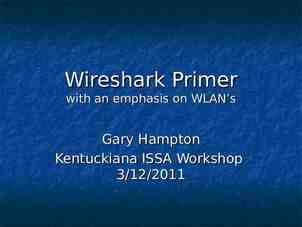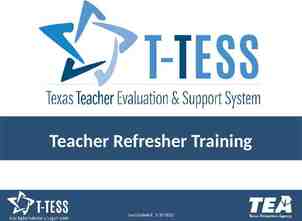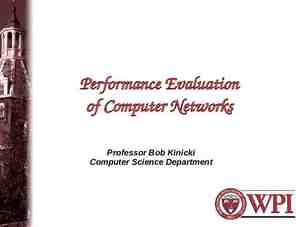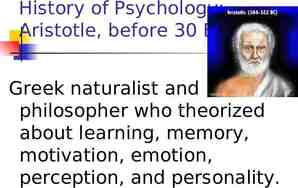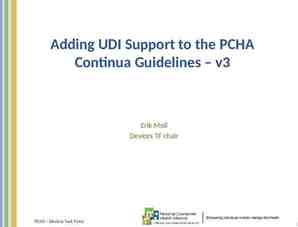Culinary Nutrition Culinary Arts
27 Slides4.25 MB

Culinary Nutrition Culinary Arts

Copyright Texas Education Agency, These Materials are copyrighted and trademarked as the property of the Texas Education 2017. Agency (TEA) and may not be reproduced without the express written permission of TEA, except under the following conditions: 1) Texas public school districts, charter schools, and Education Service Centers may reproduce and use copies of the Materials and Related Materials for the districts’ and schools’ educational use without obtaining permission from TEA. 2) Residents of the state of Texas may reproduce and use copies of the Materials and Related Materials for individual personal use only, without obtaining written permission of TEA. 3) Any portion reproduced must be reproduced in its entirety and remain unedited, unaltered and unchanged in any way. 4) No monetary charge can be made for the reproduced materials or any document containing them; however, a reasonable charge to cover only the cost of reproduction and distribution may be charged. Private entities or persons located in Texas that are not Texas public school districts, Texas Education Service Centers, or Texas charter schools or any entity, whether public or private, educational or non-educational, located outside the state of Texas MUST obtain written approval from TEA and will be required to enter into a license agreement that may involve the payment of a licensing fee or a royalty. For information contact: Office of Copyrights, Trademarks, License Agreements, and Royalties, Texas Education Agency, 1701 N. Congress Ave., Austin, TX 78701-1494; phone 512-463-7004; email: [email protected]. Copyright Texas Education Agency, 2017. All rights reserved. 2

Nutrition Copyright Texas Education Agency, 2017. All rights reserved. 3

Nutrition in foodservice Chefs must be able to: Accommodate diners’ dietary request Create menu items for dietary restrictions Stay current with nutrition information Work with nutrition experts Copyright Texas Education Agency, 2017. All rights reserved. 4

Nutrition basics Copyright Texas Education Agency, 2017. All rights reserved. 5

Nutrient Groups Carbohydrates Lipids Minerals Protein Vitamins Water Copyright Texas Education Agency, 2017. All rights reserved. 6

Carbohydrates Body’s chief energy source Contributes four calories of energy per gram Two types: Complex Starch Fiber Soluble insoluble Simple Sugars Copyright Texas Education Agency, 2017. All rights reserved. 7

Lipids Contain nine calories of energy per gram Found in animal-based foods Saturated fat – solid at room temperature Unsaturated fat – liquid at room temperature Needed for normal growth and development Provide a concentrated source of energy Trans fat is created when unsaturated Copyright Texas Education Agency, 2017. All rights reserved. 8

Minerals Divided into: Major – 100 milligrams or more needed per day Trace – less than 100 milligrams needed per day Necessary for important functions such as: Bone formation Energy metabolism Proper functioning of the nervous system Water balance Copyright Texas Education Agency, 2017. All rights reserved. 9

Proteins Building blocks of the human body Food sources can be either: Animal – complete protein Plant based – incomplete protein Needed for: Growth Maintenance Repair of body tissues Copyright Texas Education Agency, 2017. All rights reserved. 10

Vitamins Aid in the formation of healthy bones and teeth Are part of the blood-clotting process Ensure proper vision Support the immune system Vitamins are either: Fat-soluble vitamins ingested when various fats are eaten Water-soluble vitamins dissolve in water Copyright Texas Education Agency, 2017. All rights reserved. 11

Water 50 to 60 percent of weight of the human body Essential part of digestion Lubricates joints Transports nutrients and waste Copyright Texas Education Agency, 2017. All rights reserved. 12

Dietary habits Copyright Texas Education Agency, 2017. All rights reserved. 13

Exercise The Dietary Guidelines for 2010 recommends to: Increase physical activity Reduce sedentary behavior Encourage physical activity in: Childcare and childhood settings Schools Walk-to-school programs Copyright Texas Education Agency, 2017. All rights reserved. 14

Emotional factors Job requirements include: Long hours of physically demanding work Work schedule of evenings, holidays and weekends Pressures can be caused by: Change Confrontation Deadlines Copyright Texas Education Agency, 2017. All rights reserved. 15

Managing stress Positive ways include: Exercise Hobbies Meditation Reading Talking to a friend Copyright Texas Education Agency, 2017. All rights reserved. 16

Healthy Kitchens, Healthy Lives Conference (click on link) Copyright Texas Education Agency, 2017. All rights reserved. 17

Nutrition: Breaking Boundaries (click on link) Copyright Texas Education Agency, 2017. All rights reserved. 18

Cooking methods Copyright Texas Education Agency, 2017. All rights reserved. 19

Dry Cookery Methods Transfer heat to food by: Conduction Hot air convection Radiation Include: Baking Broiling Deep frying Grilling Roasting Sautéing Copyright Texas Education Agency, 2017. All rights reserved. 20

Moist cookery methods Use liquid or steam in the cooking process Best used for tougher meats and fibrous vegetables Include: Boiling Poaching Simmering Steaming Copyright Texas Education Agency, 2017. All rights reserved. 21

Combination Applies both dry and moist heat techniques to the same food Includes: Braising Stewing Copyright Texas Education Agency, 2017. All rights reserved. 22

Let’s Review! Why do chefs need to know about nutrition? How many nutrient groups are there? Can you name them? What is the body’s chief energy source? What are trans fats? Are they healthy for you? There are many minerals and vitamins – how many can you name? How much of the body is water? How is working in the foodservice industry stressful? Identify the different dry and moist cooking methods. Copyright Texas Education Agency, 2017. All rights reserved. 23

Copyright Texas Education Agency, 2017. All rights reserved. 24

Questions? Copyright Texas Education Agency, 2017. All rights reserved. 25

References and Resources Images: Shutterstock images. Photos obtained with subscription. (Slides 1, 3, 4, 5, 6, 7, 8, 9, 10, 11, 12, 13, 14, 15, 16, 19, 20, 21, 22, 24, 25) Textbooks: Culinary essentials. (2010). Woodland Hills, CA: Glencoe/McGraw-Hill. Draz, J., & Koetke, C. (2014). The culinary professional. Tinley Park, IL: Goodheart-Willcox Company. Foundations of restaurant management & culinary arts. (2011). Boston, MA: Prentice Hall. Website: SDA WIC Work Resource System Appendix C: Nutrient Chart – Function, Deficiency and Toxicity Symptoms, and Major Food Sources http://www.nal.usda.gov/wicworks/Topics/FG/AppendixC NutrientChart.pdf Copyright Texas Education Agency, 2017. All rights reserved. 26

References and Resources YouTube : Healthy Kitchens, Healthy Lives Conference Healthy Kitchens, Healthy Lives is a four-day conference held at The Culinary Institute of America at Greystone in the Napa Valley. The conference brings together experts from Harvard School of Public Health, the Samueli Institute, and other leading organizations, to present state-of-the-science on diet and nutrition. These experts are joined by chefs from the CIA to lead teaching sessions for healthcare professionals who want to learn about techniques for cooking delicious healthy foods. https://youtu.be/qGmmCNe4qLo Nutrition: Breaking Boundaries JWU's groundbreaking Culinary Nutrition program is changing the science of food - and it's the first of its kind to receive ACEND accreditation. Ready to launch your dietitian, product research, spa chef or medical nutrition career? https://youtu.be/xqb YyrNHPk?list PLSpZmcyjE5lYAW6yYcNE1KiJxG SVIJLg Copyright Texas Education Agency, 2017. All rights reserved. 27

